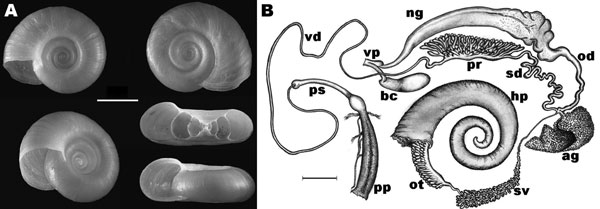Volume 14, Number 11—November 2008
Letter
Establishment of Biomphalaria tenagophila Snails in Europe
Figure

Figure. A) Shell morphology of Biomphalaria tenagophila snail from Romania. Diameter of the shell was 10–14 mm. The sinistrally coiled, flat shells are yellow-brown, discoidal, deeply and symmetrically biconcave, and consist of 5 or 6 slowly increasing whorls. The last whorl is rounded; the intermediate whorls are slightly angled on the left side. The aperture is circular or slightly ovate and angled toward the left side of the shell (i.e., toward the upper surface on the bottom right shell). Fine, parallel, rib-like transverse lines can be seen on the outer surface of the whorls. A series of photographs were prepared by focusing on different levels of the structure and these were combined by CombineZ5 (www.hadleyweb.pwp.blueyonder.co.uk), using “do combine” and “do average and filter” commands. Scale bar = 3 mm. B) Reproductive system of B. tenagophila snail from Romania; ag, albumin gland; bc, bursa copulatrix; hp, distal part of the hepatopancreas; ng, nidamental gland; od, oviduct; ot, ovotestis; pp, preputium; pr, prostate; ps, penis sheath; sd, spermiduct; sv, seminal vesicles; vd, vas deferens; vp, vaginal pouch. B. tenagophila–specific characteristics (5): >200 diverticulae of the ovotestis; 7–11 main lobes of the prostate; and presence of vaginal pouch. Scale bar = 1 mm.
References
- Malek EA. Snail-transmitted parasitic diseases, vol.1. Boca Raton (FL): CRC Press, Inc.; 1980.
- Paraense WL. The schistosome vectors in the Americas. Mem Inst Oswaldo Cruz. 2001;96(Suppl):7–16. DOIPubMedGoogle Scholar
- Pointier JP, David P, Jarne P. Biological invasions: the case of planorbid snails. J Helminthol. 2005;79:249–56. DOIPubMedGoogle Scholar
- Malek EA. Studies on “tropicorbid” snails (Biomphalaria: Planorbidae) from the Caribbean and Gulf of Mexico areas, including the Southern United States. Malacologia. 1969;7:183–209.
- Malek EA. Snail hosts of schistosomiasis and other snail-transmitted diseases in tropical America: a manual. Scientific publication 478. Washington: Pan American Health Organization; 1985.
- DeJong RJ, Morgan JA, Wilson WD, Al-Jaser MH, Appleton CC, Coulibaly G, Phylogeography of Biomphalaria glabrata and B. pfeifferi, important intermediate hosts of Schistosoma mansoni in the New and Old World tropics. Mol Ecol. 2003;12:3041–56. DOIPubMedGoogle Scholar
- Gagiu A. On the extinction of the relict snail Theodoxus prevostianus Pfeiffer 1828 in Răbăgani, Romania. Nymphaea. 2004;31:75–81.
- Dancescu P, Colea A, Gafiteanu L, Sima A. Imported tropical parasitosis in Rumania [in French]. Bull Soc Pathol Exot Filiales. 1976;69:501–7.PubMedGoogle Scholar
- Dobi S, Sántha M, Horváth A, Kassas AL, Várnai F. Introduced schistosomiasis with late complications [in Hungarian]. Orv Hetil. 1995;136:1673–5.PubMedGoogle Scholar